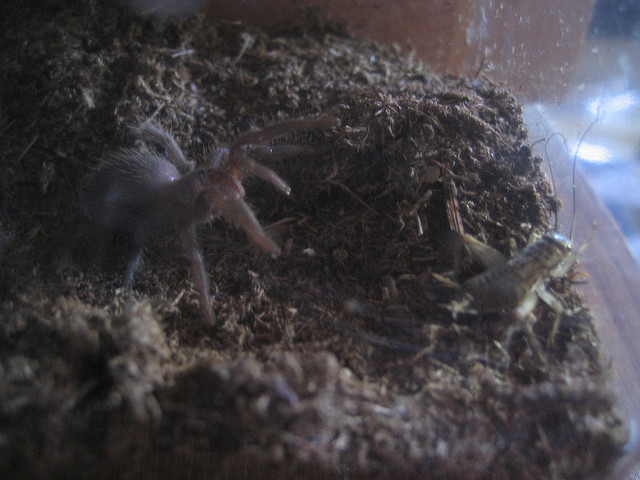Life History and Reproduction
The B. vagans lives its life in a burrow however it
builds many of these burrows during its life and populations of
spiders switching burrows is fairly common (Machkour et al.
2011 2). B. vagans females search for burrows of male
spiders to find a mate. However unlike other spider species the
Brachypelma vagans does not use chemical communication. In a
study by (Perez-Miles 2009) the Mexican Red Rump females on chemical signals
the results were that a female spiders often inhabited the
burrows of other spider’s female spiders. This result in the
wild would often cause a fight between two competing females
resulting most likely in the death of a spider. Using this
analysis the study disproved the notion that the B.
vagans uses chemical signals to distinguish burrows. The males
however are known to leave the burrow and walk far away from
their home population to find a mate. However the exact distance
is unknown. According to Machkour and Henaut males of the
Brachypelma vagans have not dispersed as often in rural town
settings as they would in a more isolated Environment.
between two competing females
resulting most likely in the death of a spider. Using this
analysis the study disproved the notion that the B.
vagans uses chemical signals to distinguish burrows. The males
however are known to leave the burrow and walk far away from
their home population to find a mate. However the exact distance
is unknown. According to Machkour and Henaut males of the
Brachypelma vagans have not dispersed as often in rural town
settings as they would in a more isolated Environment.
B. vagans face a threat on their reproduction due to habitat fragmantation. This breaking apart of biger areas of land into smaller section threatens biodiversity in an overall area. (Fahrig 2003) The B. vagans is affected by this change having a smaller population that reproduces which means there is more stress on indivuduals. (Fahrig 2003)(Mackhour et al. 2011 2) This means that when a population is smaller and a few organisms get killed it has a larger impact on futere generations than it would if all these small populations were intertwined.
B. vagans are sexualy mature after they are about 7 years old and females only produce 1 egg sac which contains aproximatly 300 eggs (Mackhour et al. 2013). The B. vagans produces a lot of young because many juviniles are eaten by other spider species (Mackhour et al 2013). The juviniles only live with the mother for a few weeks before they go to live off on their own (Mackhour et al 2013). The burrow that the B. vagans creates protects the juviniles from the elements. One example of this is it uses a form of silk to protect its burrow from the rain (Mackhour et al 2013).
To find out more about the Interactions that
the Mexican Red Rump Tarantula has with other animals, click
here.
Home
References